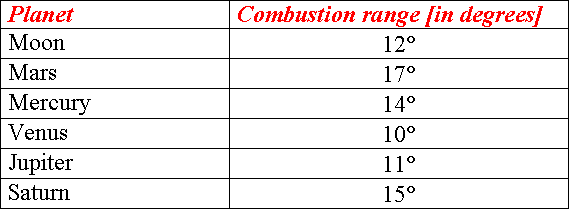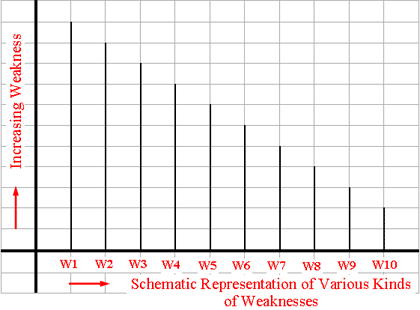Introduction
The SA Scale of Weaknesses/Strengths of the Planets
From the SA point of view then, unless a given planet satisfies every one of the following criteria for ‘strength’, it would not be considered to be fully ‘strong’. A planet in the SA is either strong, in the sense defined below, or it is deemed weak. On the whole the SA tests for strength are not only multiple, but they become for that very reason also very much more stringent. When a planet is declared to be ‘strong’ in the SA, we can be quite sure that there will be a real abundance of Divine grace coming through that planet & through its MoolaTrikona House [MTH].
As a planet can become weak, for several reasons, we are obliged to consider all these multiple factors of weaknesses, one by one.
(i) First test of strength: For the given planet to be strong, its MTH should not come under the affliction of a FM planet within the critical orb of 1°. If the affliction to the MTH is from the MMP [Most Malefic Planet], the orb of affliction is required to be more than the critical value of 2°. Conversely if the MTH of the given planet is afflicted by a FM, within the critical orb of 1°, the ‘otherwise strong’ planet is rendered weak. This weakness, due to the affliction to the planet’s MTH is considered in the SA to rank ‘first’ [W1] among the hierarchy of weaknesses, as this is the worst kind of weakness.
(ii) Second test of strength: A planet, to be strong, must be well placed. That is, it must be placed in a benefic H, which has to be other than the malefic Hs or the duhsthanas, namely the VIH, VIII & the XIIH. But even here, the second test of strength does not ‘pass’ a planet as being strong unless the MEP of this H of placement is free of affliction from a FM planet, within an orb of 1°. Conversely, any planet will become weak if its H of placement is afflicted by a FM, within an orb of 1°. Such a weakness is considered in the SA to be the second worst, and therefore this weakness ranks ‘second'[W2] in the hierarchy of weaknesses.
(iii) Third test of strength: This test of strength stipulates that for a given planet to be strong, it should not come under the malefic affliction of an FM, within an orb of 1°. If the afflicting FM is the MMP, then the planet can still be strong if it becomes free of the affliction of the MMP, by its orb of affliction being greater than 2°. Conversely, when a given planet is under the affliction from a FM, within an orb of 1°, the ‘otherwise strong’ planet becomes weak. This weakness coming from the affliction from a FM planet, ranks ‘third’ [W3] among the hierarchy of weaknesses.
(iv) Fourth test of strength: For the given planet to be strong in the SA, it must be free of the weakness of Combustion. By Combustion is meant a kind of ‘eclipsing action’, exercised by the Su, because the planet in question has become too proximate to it. It is to be understood, by analogy with the Moon losing its brightness, as its proximity to the Su decreases, becoming devoid of all brightness, on the day of Amavasya, or the New Moon. The ‘range of Combustion‘ varies from one planet to another and is given, in the SA, by the following table of ‘Combustion range‘:

A given planet is judged to be free of the weakness of combustion, when its orb of separation w.r.t. the Sun, exceeds the above critical value of the orb of combustion. This weakness of a given planet, coming from ‘combustion’, ranks ‘fourth’ [W4] among the hierarchy of weaknesses.
(v) Fifth test of strength: For a given planet to be strong, it should be well placed, in a benefic H and should not be placed in any one of the duhsthanas or the malefic Hs, namely in the VIH, VIIIH or the XIIH. The SA considers placement in the duhsthanas to be itself tantamount to ‘affliction’. Conversely, any planet placed in the duhsthanas becomes weak. This weakness coming from ‘bad placement’ ranks ‘fifth’ [W5] among the hierarchy of weaknesses. It may be noted that it is certainly not the worst kind of weakness.
(vi) Sixth test of strength: For the given planet to be strong, it should not be placed in its debilitation sign in the Rasi chart. Conversely, when a planet is debilitated in the Rasi chart, it automatically becomes weak and there never arises the question in the SA of the ‘cancellation of debility’. This weakness of debilitation of a planet in the Rasi chart ranks ‘sixth’ [W6] among the hierarchy of weaknesses.
(vii) Seventh test of strength: The given planet, to be strong, should neither be in infancy nor in old-age. If the longitudinal position of the given planet is between 0° and 5°, it is said to be in infancy and hence weak; whereas, when its longitude is between 25° and 30°, it is said to be in old age and again hence weak. This weakness due to infancy / old age ranks ‘seventh’ [W7] among the hierarchy of weaknesses.
(viii) Eighth test of strength: For the given planet to be strong, it should not occupy its debilitation Sign in the Navamsa Div. Chart, which is the most important of all the Div. Charts. Conversely, if a planet is debilitated in the D-9 chart but is otherwise well-placed and ‘strong’ in all other respects; the SA still considers it to be only a weak planet. However, this weakness ranks ‘eighth’ [W8] among the hierarchy of weaknesses.
(ix) Ninth test of strength: A planet can be strong only if its dispositor is also ‘strong’, by the same criteria of strengths. Dispositor of a planet is defined as the lord of the MTH in which the planet is placed. Conversely, whenever the dispositor of a planet is weak, that planet also automatically becomes weak. This weakness due to the weakness of the dispositor ranks ‘ninth’ [W9] among the hierarchy of weaknesses.
(x) Tenth test of strength: In the SA, there are nine independent tests of strength for each planet, the only exception being the Mo, for which alone, there is an additional independent test of strength. For the Mo to be strong, its orb of separation from the Su should be 72° or more on either side. Conversely, if the Mo’s orb of separation from the Su is less than 72°, the Mo is deemed weak in the SA. This weakness is the least among all the hierarchy of weaknesses and therefore ranks ‘tenth’ [W10] & last in the hierarchy. Accordingly, when the Mo is closer to the Su than the critical orb of 72°, the SA views this as not such a serious weakness.

When we come to Part IX, which is devoted to actual case studies, we will have the occasion to apply this detailed knowledge of the strengths and weaknesses of the Navagrahas.
(xi) ‘Afflictions’ are not simple Weaknesses:
Weaknesses of Planets / Hs must be distinguished from ‘afflictions’, which also, incidentally weaken Planets/Hs. To understand the nature of this ‘affliction’ we can think of the ‘affliction’ as arising, whenever an enemy unknowingly wanders into the firing-line of a soldier who has received an ‘eternal command’ to go on firing!
It is the nature or swadharma of the soldier to go on firing, just as the FMs have the nature and swadharma to go on ‘afflicting’, whenever any other Planet/House wanders into their orb of ‘affliction’ during routine planetary Transits. It is as though when an ‘affliction’ is present in ‘the mood of Isvara [God] at the time of birth’ – either to a Planet or to a House – this is, so to speak, ‘etched and remembered’ and ‘held’ in the universal consciousness of Isvara and will therefore naturally come to have its untoward karmic-consequences, as a result of the law of causation [Karma]; except in the singular circumstance that we take the pains to resort to Remedial Measures [Propitiatory Charities], and thereby ‘gradually nullify’ that ‘affliction’ that was present in ‘the mood of Isvara at the time of birth’.
In the SA, all afflictions are not considered to be equally weakening and equally severe. A normal affliction, means an affliction [either through conjunction or aspect] involving only a single FM planet, which is itself not placed in a malefic H, and which is itself not under the affliction of another FM planet.
On the other hand, a strong affliction [i.e. double] to a given planet or H, occurs in the following four distinct situations.
(i) The afflicting single FM planet is placed in a malefic H, on account of which the maleficity of the affliction may no longer be considered normal, but rather strong – namely ‘double’.
(ii) The affliction comes, not from a single FM planet; but rather from both the Nodes, Ra and Ke [a conjunction with one of the Nodes and an aspect from the other]. In this case, the affliction must again be deemed strong and ‘double’, rather than normal and single.
(iii) The afflicting planet could be a single FM, but when it is itself under an affliction from another FM; certainly the maleficity is again strong and ‘double’, and not normal and single.
(iv) The afflicting FM planet is not of the ordinary FM kind, but, when it is the MMP, then the affliction is certainly of the strong and ‘double’ type, and not of the normal and single type. In all the four situations cited above, we have the same intensity of affliction – namely a strong affliction [i.e. double]. A strong planet, to escape such a strong double affliction, must have an orb of affliction greater than critical value of two degrees.
When we come to Part IX, which is devoted to actual case studies, we shall have an opportunity to apply this detailed knowledge of afflictions, for understanding ‘karmic-obstacles’ in people’s lives.

